Abstract
Given the corrosion tendency of the natural oxide film of aluminum alloys, micro arc oxidation (MAO) treatment is used as an efficient and economic method to enhance the corrosion resistance. However, irregular voids, pores, and micro cracks are easily formed during the MAO process, which are harmful to the anti-corrosion property of MAO coatings. In this paper, binary additives of electrolytes, including (NaPO3)6 and H3BO3, were used to obtain MAO coatings with improved thickness and compact microstructures on 6061 aluminum alloys. The as-prepared coatings were investigated using a thickness meter, scanning electron microscope (SEM), X-ray diffractometer (XRD), and electrochemical impedance spectroscope (EIS). The results showed that the coordinated influence of the binary additives could change the discharge behaviors and micro morphologies of the MAO coatings compared to the base silicate electrolyte. A thicker and stronger MAO coating could be achieved, which was mainly composed of Al2O3 phases. The EIS tests revealed that the corrosion current density of the obtained optimal MAO coating decreased by three orders of magnitude from 1.209 × 10−6 A·cm−2 to 2.981 × 10−9 A·cm−2. We believe that the binary additive-enhanced MAO coatings could provide a promising anti-corrosion solution in various applications.
1. Introduction
Aluminum (Al) is one of the most widely used metals for industrial and general applications. One of the cheapest and easily available aluminum series is the Al 6000 series, which is widely employed in heavy-duty structures, railroad automobiles, pipelines, aviation, trucks, and marine structures [1]. The 6061 aluminum alloys are typical of the Al 6000 series with low specific gravity, high specific strength, non-magnetism, and good low-temperature properties; they are used as structural materials in many fields. However, high porosity and low thickness are two key characteristics of the oxide films naturally formed on the aluminum alloys. Localized corrosion attack, e.g., intergranular corrosion, pitting corrosion, etc., tends to take place at the weak points of the oxide films. The poor corrosion resistance caused by the active chemical properties of aluminum and its alloys greatly restricts their operation life and further applications [2]. In order to improve the corrosion properties of aluminum alloys, great efforts were made using different surface modification methods, such as superhydrophobic surfaces [3,4], conversion coatings [5,6], micro arc oxidation (MAO) [7,8,9], anodic oxidation [10,11], and laser cladding [12,13].
As one of the typical surface processing methods, MAO is also referred to as plasma electrolytic oxidation, micro plasma oxidation, or micro arc discharge oxidation. The studies of MAO coatings attracted considerable interest since the 1980s because of its novel and promising properties, such as its effective, economical, and good adhesion between substrate and coating [14,15]. Although MAO can develop a continuous ceramic oxide layer on metallic substrates, some micro pores and cracks can simultaneously be formed on the surface. The corrosive ions can penetrate the coatings and reach the substrates, which alters the surrounding corrosion circumstances and corrodes the substrate. Therefore, increasing the thickness and reducing the porosity of MAO coatings are two effective methods of enhancing the anti-corrosion properties of these coatings. Many factors can affect the thickness and porosity of MAO coatings, such as elements in the metal substrate [16,17], compositions of the electrolyte [18,19,20], processing time [21,22], processing temperature [23], current density [24,25,26], the type of power source [27,28,29], and other process assistance methods [30,31,32].
Among these techniques, additive manufacturing is one of the simplest and most promising ways to achieve various enhancements of coating properties, such as thickness, wear resistance, and anti-corrosion property. In order to improve the properties of MAO coatings, different additives are applied to the electrolyte during processing. It is expected that MAO coatings prepared using different additives could develop better microstructures with improved anti-corrosion performance. For example, Ma et al. [33] investigated the effects and mechanisms of (NaPO3)6 on AZ31 magnesium alloy during micro arc oxidation. The results showed that the thickness of coatings increased while the size of pores and cracks on the coatings also increased with (NaPO3)6 concentration. Due to the excellent microstructure of the inner layer formed at lower (NaPO3)6 concentration, the corrosion resistance of the coatings decreased with the increase in (NaPO3)6 concentration. Babaei et al. [34] fabricated an MAO coating on commercial pure titanium in the electrolyte of sodium dihydrogen phosphate with the addition of Na2ZrO3 at a fixed voltage of 500 V. The electrolyte additive was found to mitigate the long-term degradation of the coatings to a significant extent. Tran et al. [35] revealed that anomalous layer-thickening of 6061 Al alloy could be achieved by simply adding ammonia water into the sodium silicate electrolyte and using a direct current (DC) power supply. The mechanism of anomalous thickening was attributed to the formation of an amorphous surface layer which entrapped a large amount of solid debris formed during the discharging process. Tang et al. [36] prepared MAO coatings on AZ91D magnesium alloys in electrolytes containing various concentrations of K2TiF6. They reported that the increase in K2TiF6 concentration increased the coating thickness and changed the color of the MAO coatings from gray to blue-black and gray-black. The MAO coatings formed in the electrolyte with 8.0 g/L K2TiF6 possessed a highly uniform morphology and an excellent corrosion resistance.
In our previous work [37], 6061 aluminum alloy was treated with micro arc oxidation using solo or binary additives in a base silicate electrolyte system. The base electrolyte was composed of Na2SiO3, NaOH, and C3H8O3, which were uniformly dissolved in deionized water. In order to find the favorable effect of (NaPO3)6 or H3BO3 additives in the base electrolyte on the 6061 aluminum alloy, various concentrations of (NaPO3)6 or H3BO3 were individually added to a simple base alkaline silicate electrolyte. This was also expected to reduce disturbances from other additives.
Based on the research above, it can be verified that solo additives could influence the MAO process in different ways. (NaPO3)6 was a promising way of developing thicker coatings in the silicate electrolyte system. However, the addition of (NaPO3)6 usually caused complex evolution in micro-discharges and microstructures. Accompanied with the thickening of the coatings, the size of micro pores in the coatings also increased and the compactness of the passive film decreased with increasing (NaPO3)6 concentration [33]. It is necessary to find an effective method to overcome these defects. Since different additives have various influences, it is expected that binary additives could have more promising actions than solo additives. However, it remains unclear how the binary additives change the microstructure and corrosion properties of the MAO coatings. Research works on the fabrication and investigation of binary additive-enhanced MAO coating are rare.
In this paper, (NaPO3)6 and H3BO3 were simultaneously added into the base electrolyte as binary additives to further improve the thickness, compactness, and corrosion resistance properties of the MAO coatings. The composition of binary additives in the electrolyte was optimized. The microstructure and anti-corrosion properties of the MAO ceramic coatings were investigated. The influences of binary additives on the growth mechanism and anti-corrosion resistance of MAO coatings were studied in detail. Additionally, the correlations between the growth mechanism and properties of binary additives were discussed. This work explored a further way of optimizing binary additives in the processes so as to obtain high-quality MAO coatings on aluminum alloys.
2. Experimental Details
2.1. Materials and Regents
The 6061 aluminum alloy was produced by Chalco Shandong Co., Ltd. (Zibo, China), whose chemical composition (mass fraction, wt.%) is shown in Table 1. The plate was tailored to 30 mm × 30 mm × 8 mm through wire cut electrical discharge machining. Sodium chloride (NaCl), sodium silicate (Na2SiO3), sodium hydroxide (NaOH), glycerol (C3H8O3), sodium hexametaphosphate ((NaPO3)6), and boric acid (H3BO3) were purchased from Aladdin Industrial Corporation. All of these materials were analytically pure. All the experimental regents were utilized as received without further purification.

Table 1.
Chemical composition of 6061 aluminum alloy (mass fraction, wt.%).
2.2. Fabrication of MAO Coating
The samples were firstly polished using abrasive papers with different grades (from #200 to #1200) until no obvious scratches could be seen under a metallurgical microscope. After degreasing with acetone, the samples were washed in deionized water and dried in warm air. Then, the MAO processes were carried out using a pulse power supply (HNMAO-20A, Hao Rang Technology, Nanjing, China). The samples were connected as the anode, while a rectangular stainless-steel tank was used as the cathode. A centrifugal pump was employed to stir the electrolyte at 90 L/min to keep the electrolyte temperature lower than 40 °C. The silicate electrolyte was composed of Na2SiO3 (10 g/L), NaOH (1.0 g/L), and C3H8O3 (4 mL/L). During the MAO treatment, the power supply kept a constant output voltage of 450 V with a processing time of 15 min. After MAO, the samples were washed with distilled water and dried using a hairdryer.
Based on our previous study, when the additives were added individually, the coatings achieved better performance when (NaPO3)6 was 0.75 g/L or H3BO3 was 1.5 g/L in the electrolyte. As a continuation of the study, nine different combinations of binary additive samples were designed, as listed in Table 2. All samples were processed under the same parameters.

Table 2.
Content of binary additives (g/L).
2.3. Characterization
An eddy current thickness meter (GTS8202, Guoou Electronic, Guangzhou, China) was used to test the thickness of the MAO coatings at five different locations on the samples for averaging. The phase composition of the samples was evaluated by means of an Ultima IV X-ray diffractometer (XRD, Cu Kα radiation, Rigaku, Japan), with a working voltage of 40 kV and a 0.05° step size over the 2θ range of 10°–80°. Surface and cross-sectional morphologies of the coatings were observed using a scanning electron microscope (SEM, Hitachi TM3030, Tokyo, Japan).
2.4. Electrochemical Tests
The corrosion properties of the coatings were tested by electrochemical impedance spectroscopy (EIS, Ametek Parstat 4000+, Tennessee, USA) and potentiodynamic polarization tests after 1 h of immersion in 3.5 wt.% NaCl solution. The coatings were placed in a three-electrode cell kit with a standard Ag/AgCl electrode operating as the reference and a platinum plate acting as the counter electrodes. An electrochemical workstation (model PARSTAT 4000+) was used to evaluate the corrosion behavior. EIS measurements were carried out at an open-circuit potential (OCP) with an alternating current (AC) amplitude of 10 mV over a frequency range of 105 Hz to 10−2 Hz. The collected EIS data were analyzed using ZSimpWin software (v3.60). The potential scan rate was 0.167 mV∙s−1.
3. Results and Discussion
3.1. Thickness and Phase Structure
The thickness of MAO coatings with and without binary additive electrolytes is shown in Figure 1. When the 6061 Al alloy was processed without additive in the silicate electrolyte, the thickness of the MAO coatings was 6.5 μm. When the binary additives were simultaneously added to the base electrolyte, the thickness of the coatings varied based on their separate rules as a single additive. The thickness of the MAO coatings changed from 6.1 μm to 8.4 μm. That is, when the content of the (NaPO3)6 was fixed, the thickness of the coatings decreased with the increase in H3BO3 content. On the contrary, the thickness of the coatings increased with the increase in (NaPO3)6 content when the content of H3BO3 was fixed. It can be noted that (NaPO3)6 and H3BO3 could be used to modify the coatings in a synergistic manner.
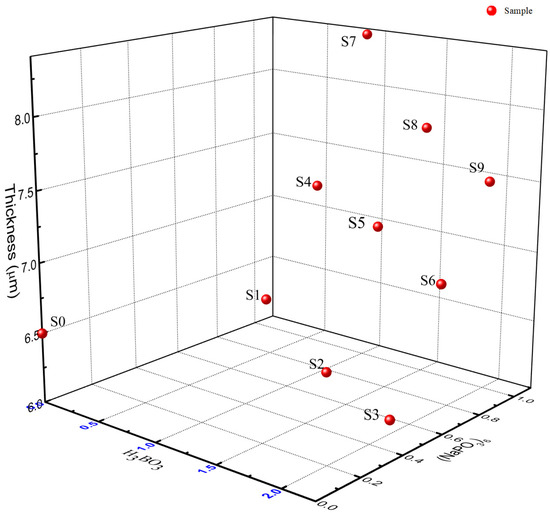
Figure 1.
Thickness of micro arc oxidation (MAO) coatings with different binary additives.
When (NaPO3)6 was added to the electrolyte, it hydrolyzed to yield Na+ and PO43− in deionized water. The conductivity of electrolyte increased with the increase in conductive ions. As a result, the resistance of arc discharge decreased. This was beneficial for a lower striking voltage and enhanced arc discharge at the substrate. Therefore, more molten Al2O3 could be spewed out and superimposed onto the substrate in the cooling electrolyte. The coatings thickened more rapidly than without (NaPO3)6 addition. On the contrary, when H3BO3 was added to the electrolyte, the pH value of the electrolyte decreased because of its weak acidity. The conductivity also decreased. On the other hand, passivation films on the 6061 aluminum substrates were promoted when H3BO3 was introduced into the electrolytes. All of this resulted in a higher striking voltage. Both the number and the size of the arc discharges decreased. Compared with the coatings without H3BO3 addition, the reaction rate of Al2O3 on the substrate reduced. Less molten Al2O3 brought about thinner coatings.
XRD patterns of the as-deposited surface layers of S1–S9 MAO coatings, depicted in Figure 2, demonstrated that the coatings were mainly composed of Al2O3 phases. Since the coatings were not thick enough, the characteristic diffraction peaks of aluminum were very strong. It can also be seen from Figure 2 that the content of Al2O3 increased with the increase in (NaPO3)6 content.
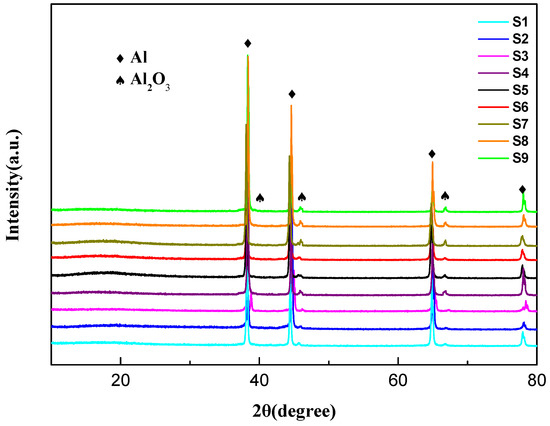
Figure 2.
X-ray diffraction (XRD) patterns of MAO coatings fabricated with different binary additives.
3.2. Microstructural Characteristics
The cross-section morphologies of MAO coatings with different additives are illustrated in Figure 3. All of the coatings adhered firmly to the substrate. The coatings could be divided into an outer porous layer and a dense inner layer. However, there were many micro pores and cracks in the coatings developed using a base electrolyte and solo additive electrolyte (Figure 3a–c). In contrast, the coatings with binary additives (Figure 3d) showed a more compact nature with few defects and a regular thickness of about 7.2 μm. Under the same processing parameters, the thickness of S5 coating was enhanced by 11% compared to the base electrolyte. Although the S5 coating was thinner than the solo (NaPO3)6 additive coating (Figure 3b), the S5 coating was compact and showed no obvious micro cracks. Furthermore, compared to the solo H3BO3 additive coating, the S5 coating showed an 18% thickness enhancement and a more compact morphology. Therefore, the binary additives could achieve not only thickening with the (NaPO3)6 additive, but also compacting with the H3BO3 additive. The binary additives could develop thicker and more compact coatings, which demonstrated better protection of the substrate. Figure 4 shows the surface morphologies of the MAO coatings with and without binary additives. Some cavities such as craters and micro-cracks existed in the MAO coatings as shown in Figure 4. After the binary additives were added to the electrolyte, the number of craters and micro-cracks decreased. The microstructure of the S5 coating became uniform and compact. Most of the micro-cracks were healed. Therefore, the S5 coating was revealed to be a promising barrier to corrosive medium.
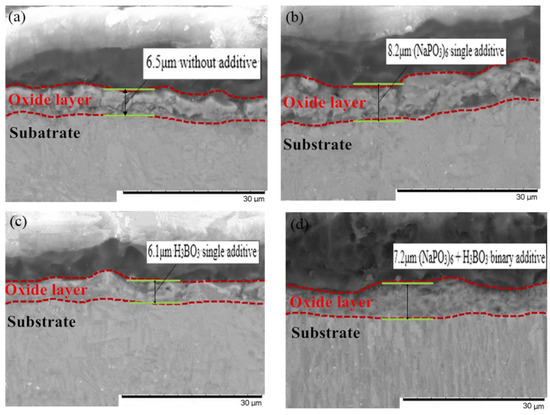
Figure 3.
Cross-section morphology of MAO coating with different additives: (a) no additive; (b) solo 0.75g/L (NaPO3)6 additive; (c) solo 1.5g/L H3BO3 additive; (d) binary 0.75g/L (NaPO3)6 + 1.5g/L H3BO3 additive.
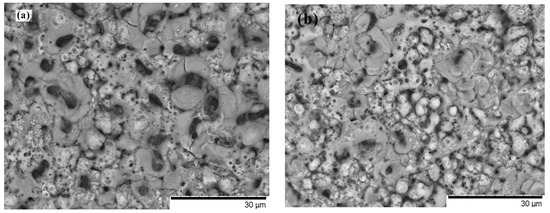
Figure 4.
Surface morphology of MAO coating with different additives: (a) S0; (b) S5.
In theory, the micro pores on the surface of the MAO coatings were the discharge paths of the electric current. Therefore, sparks occurred at the discharging areas. The intensity and frequency of the sparks reflected the micro morphology of the MAO coating. The addition of H3BO3 to the electrolyte containing (NaPO3)6 had a significant effect on the morphology of the MAO coating. With an increase in the H3BO3 concentration, the micro arcs on the Al alloy sample became smaller and more uniform. When there was no H3BO3 addition to the electrolyte, the sparks were big and uneven. The coatings grew coarsely. Conversely, the sparks became small and uniform after adding H3BO3 to the electrolyte. The coatings exhibited a compact nature. The results proved that binary additives could change the discharge behaviors in the base silicate electrolyte, as well as the micro morphology of the MAO coating. The compact microstructure could improve the protection effect of the MAO coatings on the aluminum substrate.
3.3. EIS Analysis
EIS was employed to investigate the corrosion characteristics of S1–S9 MAO coatings. The complex impedance (Nyquist) plots of S1–S9 samples are demonstrated in Figure 5. Based on the impedance plots and the microstructural features of the coatings (shown in Figure 3), the appropriate equivalent circuit models Rs (Qp (Rp (Qb Rb))) were proposed, as shown in Figure 6. Using the equivalent circuit model shown in Figure 6, the Nyquist plots were fitted. The values of the fitting results of S1–S9 samples with the equivalent circuit model are shown in Table 3. Rp represents the resistance of the outer porous layer, which specifically reflects the resistance to defects. Rb denotes the dense inner layer resistance. Qp and Qb are the capacitance of the inner layer and outer layer, respectively. Rs is the resistance of the electrolyte.
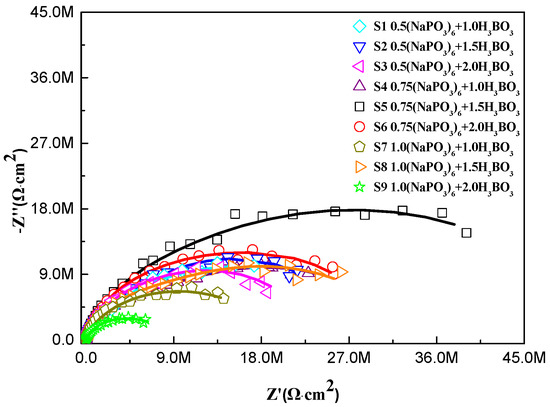
Figure 5.
Electrochemical impedance spectroscopy (EIS) plots of MAO coatings obtained with different additives.
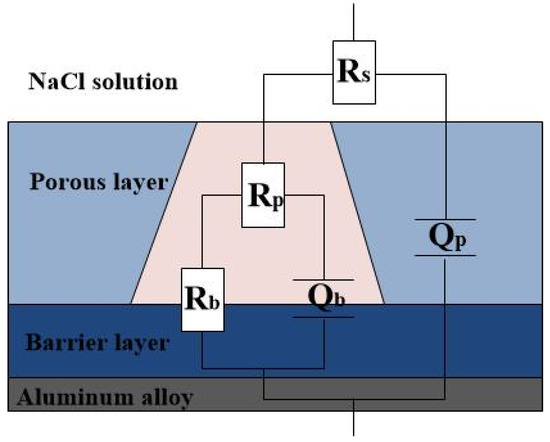
Figure 6.
Equivalent circuit model for the EIS data of MAO coatings.

Table 3.
Fitting results for EIS of MAO coatings with different additives.
To classify the coatings, the samples could be divided into three groups, i.e., S1–S3, S4–S6, and S7–S9. As we can see in Table 3, Rp and Rb changed regularly. When the content of (NaPO3)6 was fixed, both Rp and Rb increased firstly and decreased secondly with the content of H3BO3 increasing. This indicated that the anti-corrosion properties of the MAO coatings also increased firstly and decreased secondly. On the contrary, Rp decreased gradually when only H3BO3 was added to the base electrolyte. This conversion came from the combination function of binary additives. The binary additives could thicken and compact the MAO coatings. When the contents of (NaPO3)6 and H3BO3 reached 0.75 g/L and 1.5 g/L respectively, the S5 sample demonstrated the biggest Rp and Rb, i.e., 2.111 × 107 Ω·cm2 and 3.814 × 108 Ω·cm2. In contrast, the coatings processed in the base electrolyte only achieved 4.36 × 106 Ω·cm2 (Rp) and 3.263 × 106 Ω·cm2 (Rb). Rp increased by one order of magnitude. At the same time, Rb was enhanced by two orders of magnitude. The corrosion resistance of the coatings was controlled mainly by their thickness and compactness. The coatings prepared with reasonable binary additives, such as S5, showed thicker and more compact layers. The barrier function of S5 MAO coatings toward corrosive media could be obviously increased. As a result, the anti-corrosion properties of the coatings improved greatly.
3.4. Potentiodynamic Polarization
The potentiodynamic polarization curves of 6061 aluminum and S5 samples in 3.5 wt.% NaCl solution are depicted in Figure 7. The tests were carried out after the samples were immersed in 3.5 wt.% NaCl solution for 1 h. The largest corrosion current density (Icorr, 1.209 × 10−6 A·cm−2) showed the poor anti-corrosion properties of the bare 6061 Al sample (Table 4). On the contrary, the S5 samples revealed a more ideal performance. Specifically, its largest corrosion current density was reduced to 2.981 × 10−9 A∙cm−2. The corrosion resistance increased by three orders of magnitude compared to the bare 6061 Al alloy, from 1.581 × 104 Ω∙cm2 to 1.142 × 107 Ω∙cm2. At the same time, the S5 samples showed more positive corrosion potentials (Ecorr) than the bare 6061 Al sample, indicating better anti-corrosion performance. From these results, it was obvious that S5 MAO coatings showed better corrosion resistance.
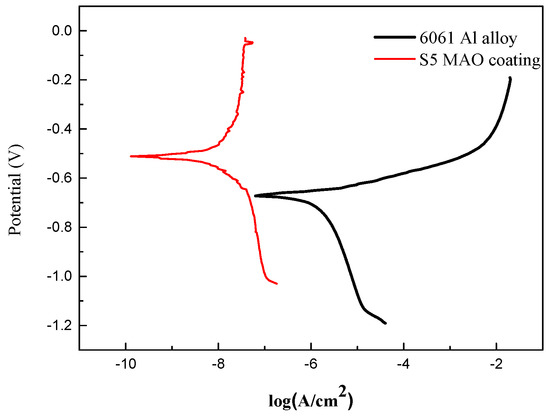
Figure 7.
Polarization curves of 6061 aluminum alloy and S5 sample.

Table 4.
Results of polarization curves for 6061 aluminum alloy and S5 sample.
4. Conclusions
The 6061 aluminum alloy was processed with micro arc oxidation in a base silicate system electrolyte using binary additives ((NaPO3)6 and H3BO3). Compared with the additives added solely, binary additives achieved a different influence on the coating microstructure and properties. Binary additives, (NaPO3)6 and H3BO3, could modify the coatings in a synergistic manner. The microstructure and anti-corrosion properties of the MAO coatings were analyzed according to the experimental data. All the coatings showed an improved thickness and compact microstructure. XRD showed that the coatings were mainly composed of Al2O3 phases. The corrosion current density of the optimal S5 coating decreased from 1.209 × 10−6 A∙cm−2 to 2.981 × 10−9 A∙cm−2, i.e., three orders of magnitude lower than the bare 6061 Al alloy. Based on the experimental results, the MAO coatings with binary additives ((NaPO3)6 and H3BO3) exhibited an effective improvement in corrosion resistance. Therefore, it could be suggested that the binary additives provide a promising way of enhancing the properties of MAO coatings.
Author Contributions
Conceptualization, Q.Z. and B.W.; methodology, B.W.; formal analysis, X.Z.; investigation, B.Z.; resources, X.Z.; writing, Q.Z. and B.Z. All authors read and agreed to the published version of the manuscript.
Funding
This research was funded by the National Natural Science Foundation of China (Grant No. 41806089 and 41827805) and the Key R&D projects in Shandong (2018GGX102035).
Conflicts of Interest
The authors declare no conflict of interest.
References
- Md, S.U.R.; Jayahari, L. Study of mechanical properties and wear behaviour of aluminium 6061 matrix composites reinforced with steel machining chips. Mater. Today Proc. 2018, 5, 20117–20123. [Google Scholar] [CrossRef]
- Yang, L.H.; Wan, Y.X.; Qin, Z.L.; Xu, Q.J.; Min, Y.L. Fabrication and corrosion resistance of a graphene-tin oxide composite film on aluminium alloy 6061. Corros. Sci. 2018, 130, 85–94. [Google Scholar] [CrossRef]
- Zhang, B.B.; Xu, W.C.; Zhu, Q.J.; Sun, Y.Y.; Li, Y.T. Mechanically robust superhydrophobic porous anodized AA5083 for marine corrosion protection. Corros. Sci. 2019, 15, 108083. [Google Scholar] [CrossRef]
- Zhang, B.B.; Xu, W.C.; Zhu, Q.J.; Yuan, S.; Li, Y.T. Lotus-inspired multiscale superhydrophobic AA5083 resisting surface contamination and marine corrosion attack. Materials 2019, 12, 1592. [Google Scholar] [CrossRef]
- Ingrid, M.; Barbara, V. Conversion coatings based on rare earth nitrates and chlorides for corrosion protection of aluminum alloy 7075-T6. Corrosion 2017, 73, 822–843. [Google Scholar] [CrossRef]
- Reni, A.; Emilia, S.; Aleksandar, T.; Maria, D.; Dimitar, S. On the Role of pre-treatment of Aluminum Substrate on Deposition of Cerium Based Conversion Layers and Their Corrosion-Protective Ability. Int. J. Electrochem. Sci. 2018, 13, 5333–5351. [Google Scholar] [CrossRef]
- Kaseem, M.; Kamil, M.P.; Kwon, J.H.; Ko, Y.G. Effect of sodium benzoate on corrosion behavior of 6061 Al alloy processed by plasma electrolytic oxidation. Surf. Coat. Technol. 2015, 283, 268–273. [Google Scholar] [CrossRef]
- Barati, N.; Yerokhin, A.; Golestanifard, F.; Rastegari, S.; Meletis, E.I. Alumina- zirconia coatings produced by plasma electrolytic oxidation on Al alloy for corrosion resistance improvement. J. Alloy. Compd. 2017, 724, 435–442. [Google Scholar] [CrossRef]
- Ji, S.P.; Weng, Y.C.; Wu, Z.Z.; Ma, Z.Y.; Tian, X.B.; Ricky, K.Y.; Lin, H.; Wu, G.S.; Chu, P.K.; Pan, F. Excellent corrosion resistance of P and Fe modified micro-arc oxidation coating on Al alloy. J. Alloy. Compd. 2017, 710, 452–459. [Google Scholar] [CrossRef]
- Wang, W.B.; Dong, P.; Wang, H.Y.; Cheng, J.; Liu, S.L. Synergistic corrosion inhibition effect of molybdate and phosphate ions for anodic oxidation film formed on 2024 aluminum alloy. J. Wuhan Univ. Technol. Mat. Sci. Edit. 2019, 34, 426–432. [Google Scholar] [CrossRef]
- Wan, Y.; Wang, H.; Zhang, Y.D.; Wang, X.M.; Li, Y.B. Study on anodic oxidation and sealing of aluminum alloy. Int. J. Electrochem. Sci. 2018, 13, 2175–2185. [Google Scholar] [CrossRef]
- Wu, X.Q.; Yan, H.; Xin, Y. Study on microstructure and properties of laser cladding Al-Ti-C coating on aluminum alloy surface. J. Nanoelectron. Optoelectron. 2018, 13, 1258–1264. [Google Scholar] [CrossRef]
- Ni, C.; Shi, Y.; Liu, J.; Huang, G.Z. Characterization of Al0.5FeCu0.7NiCoCr high-entropy alloy coating on aluminum alloy by laser cladding. Opt. Laser Technol. 2018, 105, 257–263. [Google Scholar] [CrossRef]
- Chang, S.Y.; Lin, H.K.; Tsao, L.C.; Huang, W.T.; Huang, Y.T. Effect of voltage on microstructure and corrosion resistance of microarc oxidation coatings on CP-Ti. Corros. Eng. Sci. Technol. 2014, 49, 17–22. [Google Scholar] [CrossRef]
- Shokouhfar, M.; Allahkaram, S.R. Formation mechanism and surface characterization of ceramic composite coatings on pure titanium prepared by micro-arc oxidation in electrolytes containing nanoparticles. Surf. Coat. Technol. 2016, 291, 396–406. [Google Scholar] [CrossRef]
- Krishna, L.R.; Poshal, G.; Jyothirmayi, A.; Sundararajan, G. Relative hardness and corrosion behavior of micro arc oxidation coatings deposited on binary and ternary magnesium alloys. Mater. Des. 2015, 77, 6–14. [Google Scholar] [CrossRef]
- Oh, Y.J.; Mun, J.I.; Kim, J.H. Effects of alloying elements on microstructure and protective properties of Al2O3 coatings formed on aluminum alloy substrates by plasma electrolysis. Surf. Coat. Technol. 2009, 204, 141–148. [Google Scholar] [CrossRef]
- Gao, H.T.; Zhang, M.; Yang, X.; Huang, P.; Xu, K.W. Effect of Na2SiO3 solution concentration of micro-arc oxidation process on lap-shear strength of adhesive-bonded magnesium alloys. Appl. Surf. Sci. 2014, 314, 447–452. [Google Scholar] [CrossRef]
- Karbowniczek, J.; Muhaffel, F.; Cempura, G.; Cimenoglu, H.; Czyrska-Filemonowicz, A. Influence of electrolyte composition on microstructure, adhesion and bioactivity of micro-arc oxidation coatings produced on biomedical Ti6Al7Nb alloy. Surf. Coat. Technol. 2017, 321, 97–107. [Google Scholar] [CrossRef]
- Martin, J.; Leone, P.; Nominé, A.; Veys-Renaux, D.; Henrion, G.; Belmonte, T. Influence of electrolyte ageing on the Plasma Electrolytic Oxidation of aluminium. Surf. Coat. Technol. 2015, 269, 36–46. [Google Scholar] [CrossRef]
- Bosta, M.M.S.A.; Mab, K.J.; Chien, H.H. The effect of MAO processing time on surface properties and low temperature infrared emissivity of ceramic coating on aluminium 6061 alloy. Infrared Phys. Technol. 2013, 60, 323–334. [Google Scholar] [CrossRef]
- Martin, J.; Melhem, A.; Shchedrina, I.; Duchanoy, T.; Nominé, A.; Henrion, G.; Czerwiec, T.; Belmonte, T. Effects of electrical parameters on plasma electrolytic oxidation of aluminium. Surf. Coat. Technol. 2013, 221, 70–76. [Google Scholar] [CrossRef]
- Bosta, M.M.S.A.; Ma, K.J. Influence of electrolyte temperature on properties and infrared emissivity of MAO ceramic coating on 6061 aluminum alloy. Infrared Phys. Technol. 2014, 67, 63–72. [Google Scholar] [CrossRef]
- Kaseem, M.; Min, J.H.; Ko, Y.G. Corrosion behavior of Al-1wt% Mg-0.85wt%Si alloy coated by microarc-oxidation using TiO2 and Na2MoO4 additives: Role of current density. J. Alloy. Compd. 2017, 723, 448–455. [Google Scholar] [CrossRef]
- Ezhilselvi, V.; Nithin, J.; Balaraju, J.N.; Subramanian, S. The influence of current density on the morphology and corrosion properties of MAO coatings on AZ31B magnesium alloy. Surf. Coat. Technol. 2016, 288, 221–229. [Google Scholar] [CrossRef]
- Xiang, N.; Song, R.G.; Zhuang, J.J.; Song, R.X.; Lu, X.Y.; Su, X.P. Effects of current density on microstructure and properties of plasma electrolytic oxidation ceramic coatings formed on 6063 aluminum alloy. Trans. Nonferrous Met. Soc. China 2016, 26, 806–813. [Google Scholar] [CrossRef]
- Wang, J.H.; Du, M.H.; Han, F.Z.; Yang, J. Effects of the ratio of anodic and cathodic currents on the characteristics of micro-arc oxidation ceramic coatings on Al alloys. Appl. Surf. Sci. 2014, 292, 658–664. [Google Scholar] [CrossRef]
- Xin, S.G.; Song, L.X.; Zhao, R.G.; Hu, X.F. Influence of cathodic current on composition, structure and properties of Al2O3 coatings on aluminum alloy prepared by micro-arc oxidation process. Thin Solid Films 2006, 515, 326–332. [Google Scholar] [CrossRef]
- Wang, S.L.; Zhang, P.; Du, Y.H.; Wang, Y.J.; Hao, Z.Q. Quick surface treatment of AZ31B by ac micro-arc oxidation. J. Wuhan Univ. Technol.-Mat. Sci. Edit. 2014, 29, 773–779. [Google Scholar] [CrossRef]
- Shen, D.J.; Cai, J.R.; Li, G.L.; He, D.L.; Wu, L.L.; Ma, H.J.; Xia, Y.H.; Chen, H.; Yang, Y.Q. Effect of ultrasonic on microstructure and growth characteristics of micro-arc oxidation ceramic coatings on 6061 aluminum alloy. Vacuum 2014, 99, 143–148. [Google Scholar] [CrossRef]
- Lu, P.; Fan, H.; Liu, Y.; Cao, L.; Wu, X.; Xu, X. Controllable biodegradability, drug release behavior and hemocompatibility of PTX-eluting magnesium stents. Colloid Surf. B Biointerfaces 2011, 83, 3–28. [Google Scholar] [CrossRef] [PubMed]
- Prasad Rao, K.; Janaki Ram, G.D.; Stucker, B.E. Improvement in corrosion resistance of friction stir welded aluminum alloys with micro arc oxidation coatings. Scripta Mater. 2008, 58, 998–1001. [Google Scholar] [CrossRef]
- Ma, H.J.; Li, D.L.; Liu, C.; Huang, Z.Q.; He, D.L.; Yan, Q.; Liu, P.; Nash, P.; Shen, D.J. An investigation of (NaPO3)6 effects and mechanisms during micro-arc oxidation of AZ31 magnesium alloy. Surf. Coat. Technol. 2015, 266, 151–159. [Google Scholar] [CrossRef]
- Babaei, M.; Dehghanian, C.; Vanaki, M. Effect of additive on electrochemical corrosion properties of plasma electrolytic oxidation coatings formed on CP Ti under different processing frequency. Appl. Surf. Sci. 2015, 357, 712–720. [Google Scholar] [CrossRef]
- Tran, Q.P.; Sun, J.K.; Kuo, Y.C.; Tseng, C.Y.; He, J.L.; Chin, T.S. Anomalous layer-thickening during micro-arc oxidation of 6061 Al alloy. J. Alloy. Compd. 2017, 697, 326–332. [Google Scholar] [CrossRef]
- Tang, M.Q.; Feng, Z.Q.; Li, G.; Zhang, Z.Z.; Zhang, R.Z. High-corrosion resistance of the microarc oxidation coatings on magnesium alloy obtained in potassium fluotitanate electrolytes. Surf. Coat. Technol. 2015, 264, 105–113. [Google Scholar] [CrossRef]
- Zhu, Q.J.; Wang, B.B.; Zhao, X.; Zhang, B.B. Robust micro arc oxidation coatings on 6061 aluminum alloys via surface thickening and microvoid reducing approach. Solid state Phenom. 2018, 279, 148–152. [Google Scholar] [CrossRef]
© 2020 by the authors. Licensee MDPI, Basel, Switzerland. This article is an open access article distributed under the terms and conditions of the Creative Commons Attribution (CC BY) license (http://creativecommons.org/licenses/by/4.0/).